|
|
|

|
|||||

|
|

Specialty vehicles contractor Oshkosh (NYSE:OSK) announced better-than-expected revenue in Q2 CY2025, but sales fell by 4% year on year to $2.73 billion. The company’s full-year revenue guidance of $10.6 billion at the midpoint came in 2.4% above analysts’ estimates. Its non-GAAP profit of $3.41 per share was 15.7% above analysts’ consensus estimates.
Is now the time to buy Oshkosh? Find out by accessing our full research report, it’s free.
“We delivered a strong second quarter, with adjusted earnings per share of $3.41, up 2.1 percent from the prior year, reflecting disciplined execution and broad-based strength across our portfolio,” said John Pfeifer, president and chief executive officer of Oshkosh Corporation.
Oshkosh (NYSE:OSK) manufactures specialty vehicles for the defense, fire, emergency, and commercial industry, operating various brand subsidiaries within each industry.
A company’s long-term sales performance is one signal of its overall quality. Any business can put up a good quarter or two, but many enduring ones grow for years. Regrettably, Oshkosh’s sales grew at a mediocre 7.4% compounded annual growth rate over the last five years. This fell short of our benchmark for the industrials sector and is a rough starting point for our analysis.
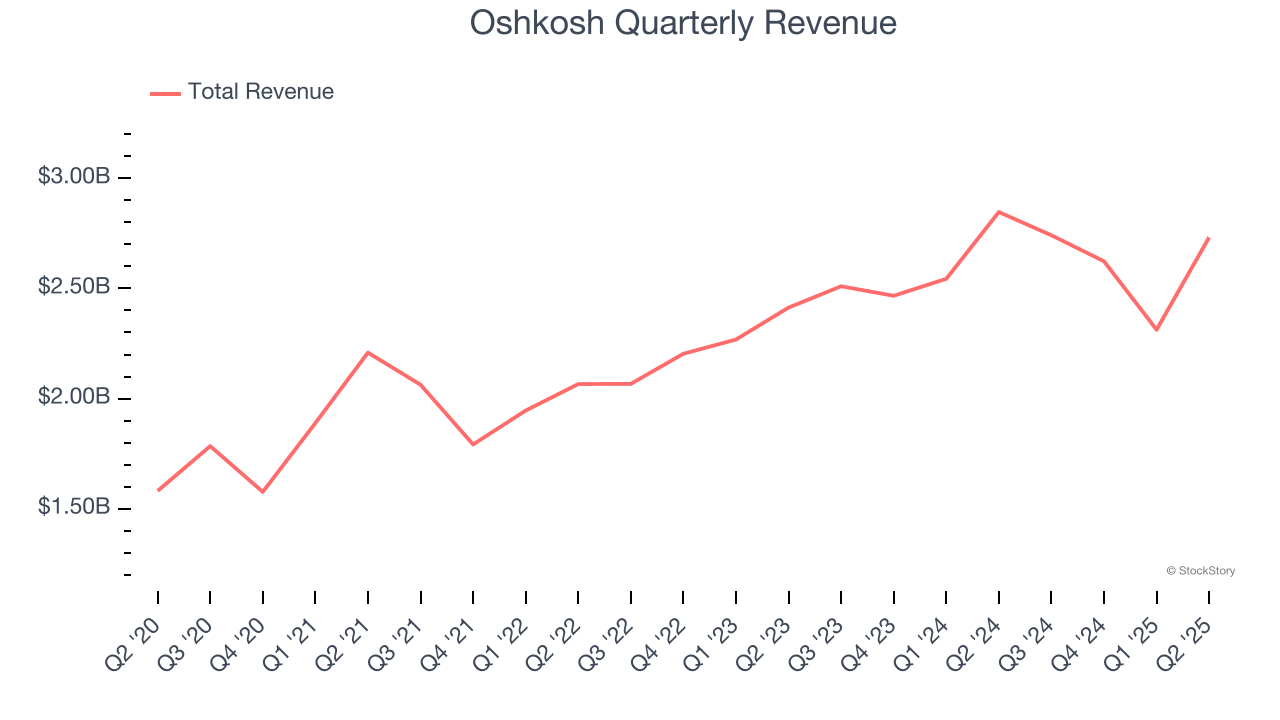
We at StockStory place the most emphasis on long-term growth, but within industrials, a half-decade historical view may miss cycles, industry trends, or a company capitalizing on catalysts such as a new contract win or a successful product line. Oshkosh’s annualized revenue growth of 7.8% over the last two years aligns with its five-year trend, suggesting its demand was stable. We also think Oshkosh’s recent performance stands out as many other Heavy Transportation Equipment businesses have faced declining sales because of cyclical headwinds.
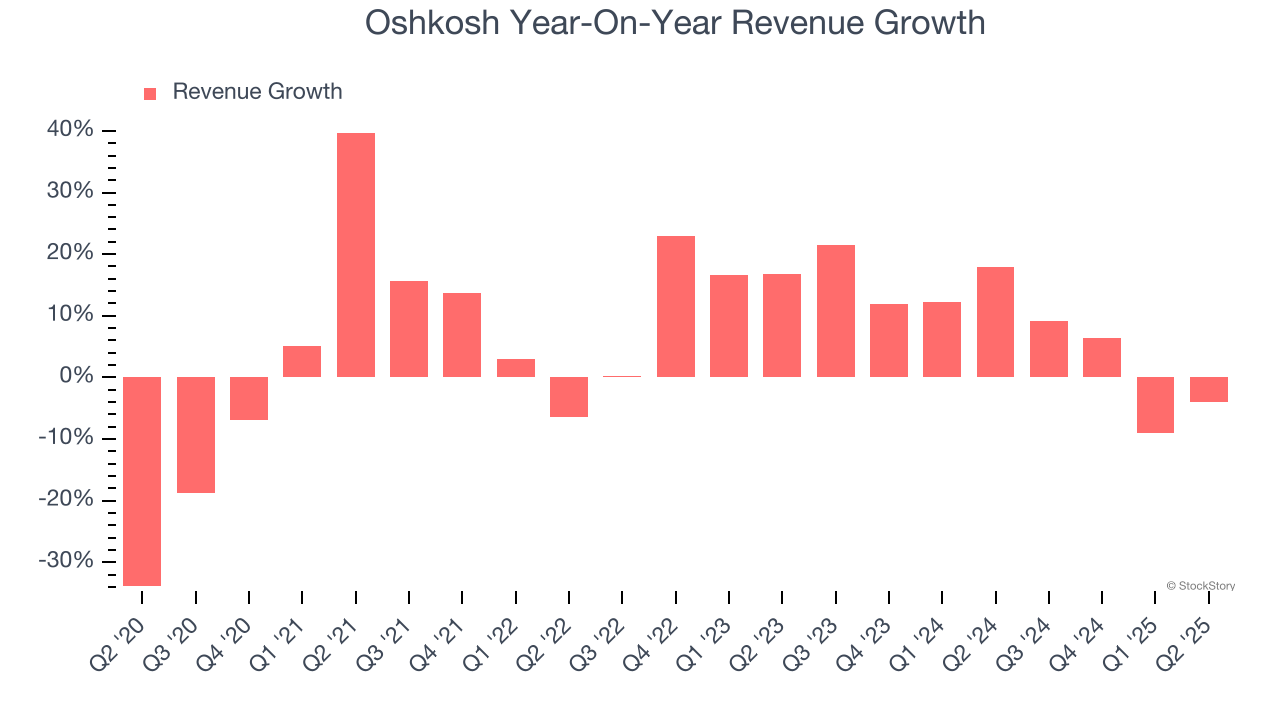
We can dig further into the company’s revenue dynamics by analyzing its backlog, or the value of its outstanding orders that have not yet been executed or delivered. Oshkosh’s backlog reached $14.23 billion in the latest quarter and averaged 1.2% year-on-year growth over the last two years. Because this number is lower than its revenue growth, we can see the company fulfilled orders at a faster rate than it added new orders to the backlog. This implies Oshkosh was operating efficiently but raises questions about the health of its sales pipeline.

This quarter, Oshkosh’s revenue fell by 4% year on year to $2.73 billion but beat Wall Street’s estimates by 0.7%.
Looking ahead, sell-side analysts expect revenue to grow 2.6% over the next 12 months, a deceleration versus the last two years. This projection doesn't excite us and suggests its products and services will see some demand headwinds.
Today’s young investors won’t have read the timeless lessons in Gorilla Game: Picking Winners In High Technology because it was written more than 20 years ago when Microsoft and Apple were first establishing their supremacy. But if we apply the same principles, then enterprise software stocks leveraging their own generative AI capabilities may well be the Gorillas of the future. So, in that spirit, we are excited to present our Special Free Report on a profitable, fast-growing enterprise software stock that is already riding the automation wave and looking to catch the generative AI next.
Operating margin is one of the best measures of profitability because it tells us how much money a company takes home after procuring and manufacturing its products, marketing and selling those products, and most importantly, keeping them relevant through research and development.
Oshkosh was profitable over the last five years but held back by its large cost base. Its average operating margin of 7.6% was weak for an industrials business. This result isn’t too surprising given its low gross margin as a starting point.
On the plus side, Oshkosh’s operating margin rose by 1.6 percentage points over the last five years, as its sales growth gave it operating leverage.
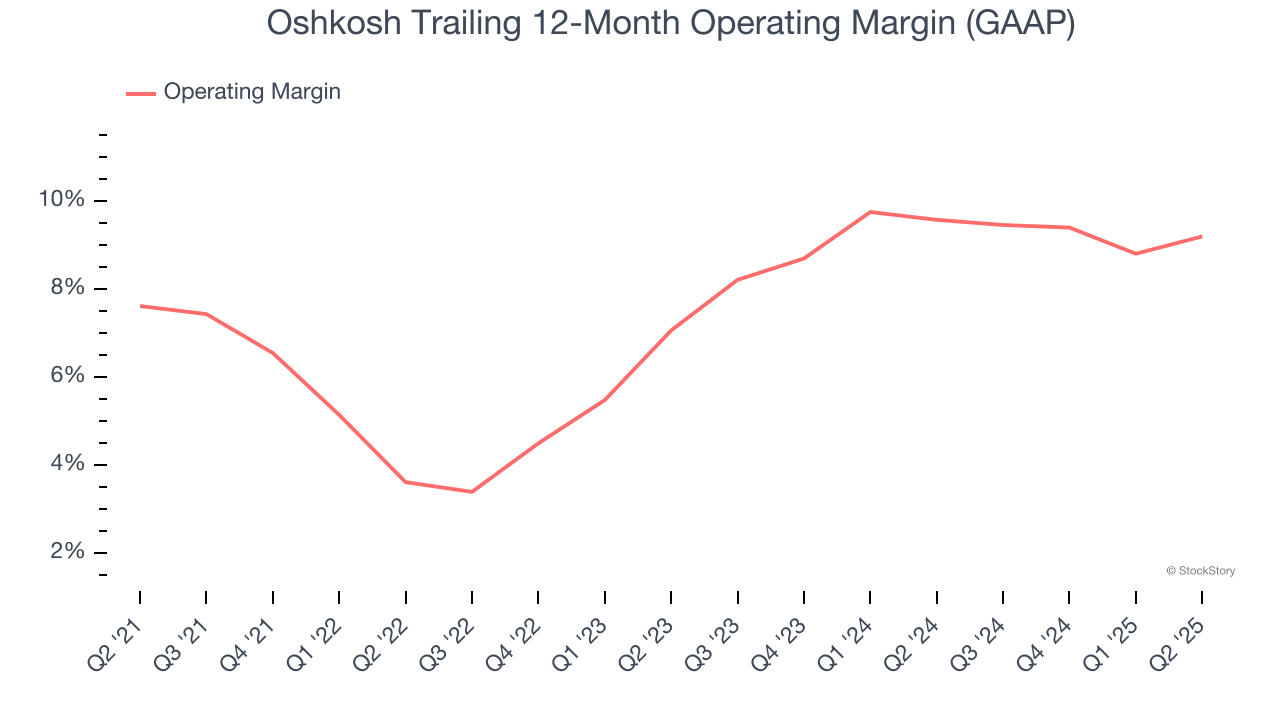
This quarter, Oshkosh generated an operating margin profit margin of 10.7%, up 1.5 percentage points year on year. The increase was encouraging, and because its operating margin rose more than its gross margin, we can infer it was more efficient with expenses such as marketing, R&D, and administrative overhead.
We track the long-term change in earnings per share (EPS) for the same reason as long-term revenue growth. Compared to revenue, however, EPS highlights whether a company’s growth is profitable.
Oshkosh’s EPS grew at a remarkable 13.3% compounded annual growth rate over the last five years, higher than its 7.4% annualized revenue growth. This tells us the company became more profitable on a per-share basis as it expanded.
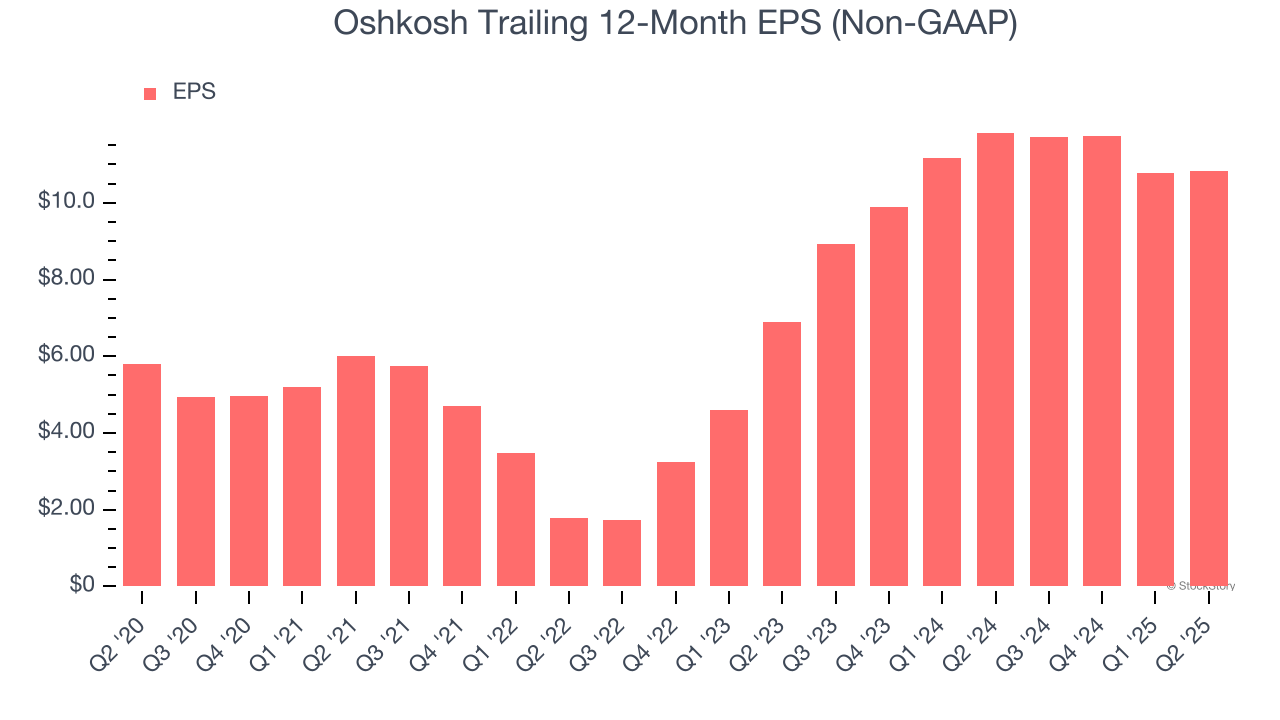
We can take a deeper look into Oshkosh’s earnings quality to better understand the drivers of its performance. As we mentioned earlier, Oshkosh’s operating margin expanded by 1.6 percentage points over the last five years. On top of that, its share count shrank by 5.5%. These are positive signs for shareholders because improving profitability and share buybacks turbocharge EPS growth relative to revenue growth.
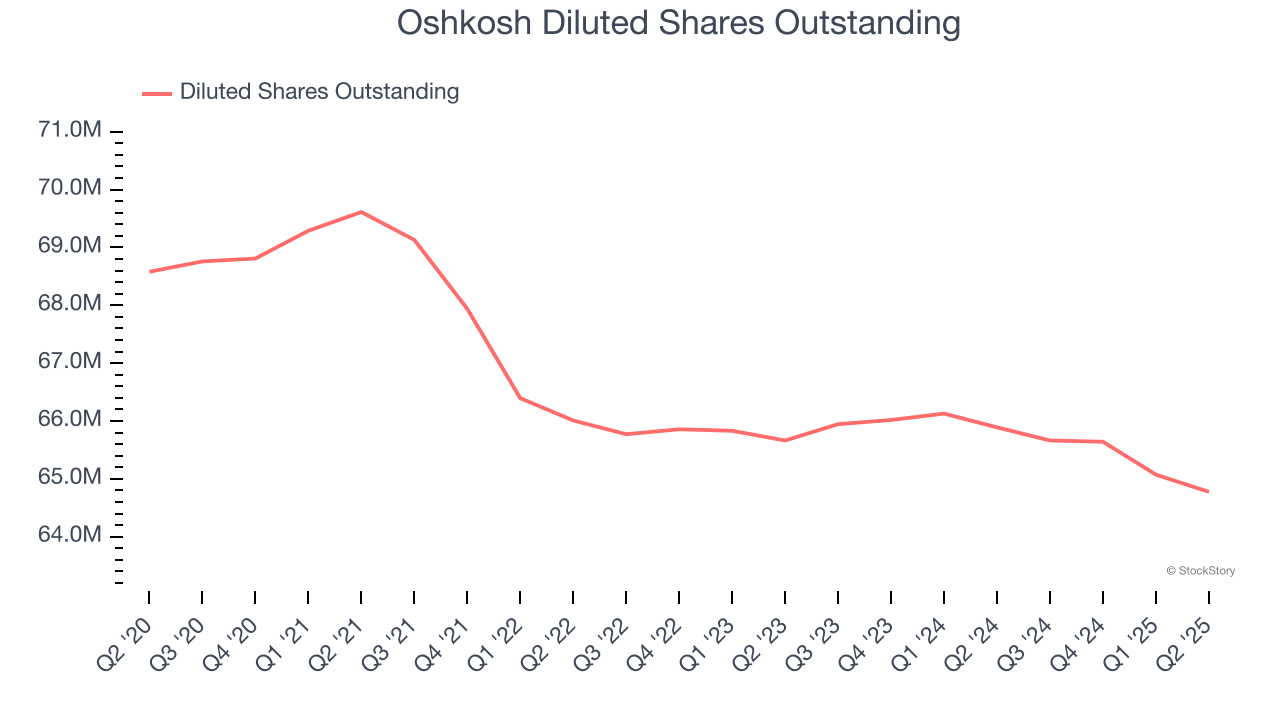
Like with revenue, we analyze EPS over a shorter period to see if we are missing a change in the business.
For Oshkosh, its two-year annual EPS growth of 25.5% was higher than its five-year trend. We love it when earnings growth accelerates, especially when it accelerates off an already high base.
In Q2, Oshkosh reported adjusted EPS at $3.41, up from $3.34 in the same quarter last year. This print easily cleared analysts’ estimates, and shareholders should be content with the results. Over the next 12 months, Wall Street expects Oshkosh’s full-year EPS of $10.84 to grow 3.6%.
We were impressed by how significantly Oshkosh blew past analysts’ backlog expectations this quarter. We were also excited its EBITDA outperformed Wall Street’s estimates by a wide margin. Zooming out, we think this was a solid print. The stock traded up 4.9% to $132.82 immediately after reporting.
Oshkosh may have had a good quarter, but does that mean you should invest right now? What happened in the latest quarter matters, but not as much as longer-term business quality and valuation, when deciding whether to invest in this stock. We cover that in our actionable full research report which you can read here, it’s free.
| Dec-09 | |
| Dec-02 | |
| Nov-28 | |
| Nov-25 | |
| Nov-18 | |
| Nov-12 |
Oshkosh Defense plans to lay off 160 workers after $52.8M decline in Q3 sales
OSK
Milwaukee Journal Sentinel
|
| Nov-11 | |
| Nov-05 | |
| Nov-05 | |
| Nov-04 | |
| Oct-30 | |
| Oct-30 | |
| Oct-30 | |
| Oct-29 | |
| Oct-29 |
Join thousands of traders who make more informed decisions with our premium features. Real-time quotes, advanced visualizations, backtesting, and much more.
Learn more about FINVIZ*Elite